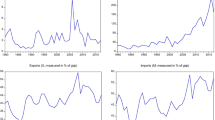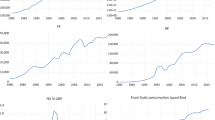Abstract
This study investigates the relationships among renewable energies (RE), carbon dioxide (CO2) emissions, foreign direct investment (FDI), foreign and non-foreign patents (FP, NFP), and trade (TR) for the case of Tunisia using time series data spanning the period 1980–2017. The autoregressive distributed lags (ARDL) model approach of Pesaran et al. (J Appl Econ 16:289–326, 2001) and the causality of Granger are employed to explore the dynamic association between the underlined variables. The results from the long-run elasticities show that FDI and TR have negative and statistically significant impacts on RE, while NFP has a positive and statistically significant effect on the consumption of RE. Both FP and CO2 emission variables are insignificant in the long run. In the short run, there are no Granger causal links between RE and patents (FP and NFP), but we have one-way causality running from CO2 emissions to patents (FP and NFP). In the long run, there are bidirectional causalities between RE, NFP, and TR. The Tunisian authorities must impose more stringent environmental standards to attract foreign investments that are more respectful of the environment, and import and export cleaner. It is also necessary to encourage R&D and innovation which appear to be beneficial for the environment.


Similar content being viewed by others
Data availability
The datasets used during the current study are available from the corresponding or first author on reasonable request.
Notes
For the FP value of the year 1982, we take the mean of the 2 years 1981 and 1983.
The robustness of the VECM model is checked using residuals Portmanteau tests for autocorrelations. The results from the test revealed no problem of autocorrelation. The result is available upon request.
References
Ang JB (2009) CO2 emissions, research and technology transfer in China. Ecol Econ 68(10):2658–2665
Apergis N, Payne JE, Menyah K, Wolde-Rufael Y (2010) On the causal dynamics between emissions, nuclear energy, renewable energy, and economic growth. Ecol Econ 69(11):2255–2260
Bashir MA, Sheng B, Doğan B, Sarwar S, Shahzad U (2020) Export product diversification and energy efficiency: Empirical evidence from OECD countries. Struct Chang Econ Dyn 55:232–243
Ben Jebli M, Ben Youssef S (2015) The environmental Kuznets curve, economic growth, renewable and non-renewable energy, and trade in Tunisia. Renew Sust Energ Rev 47:173–185
Ben Youssef S (2011) Transboundary pollution and absorptive capacity. Environ Model Assess 16(2):205–211
Ben Youssef S (2020) Non-resident and resident patents, renewable and fossil energy, pollution, and economic growth in the USA. Environ Sci Pollut Res 27:40795–40810
Ben Youssef S, Zaccour G (2014) Absorptive capacity, R&D spillovers, emissions taxes and R&D subsidies. Strateg Behav Environ 4(1):41–58
Bretschger L, Lechthaler F, Rausch S, Zhang L (2017) Knowledge diffusion, endogenous growth, and the costs of global climate policy. Eur Econ Rev 93:47–72
Brown RL, Durbin J, Evans JM (1975) Techniques for testing the constancy of regression relations over time. J R Stat Soc Ser B 37:149–163
Copeland BR, Taylor MS (2004) Trade, growth, and the environment. J Econ Lit 42(3):7–71
Costa-Campi MT, García-Quevedo J, Martínez-Ros E (2017) What are the determinants of investment in environmental R&D? Energy Policy 104(C):455–465
Dickey DA, Fuller WA (1979) Distribution of the estimators for autoregressive time series with a unit root. J Am Stat Assoc 74:427–431
Dogan B, Deger O (2016) How globalization and economic growth affect energy consumption: panel data analysis in the sample of Brazil, Russia, India, China countries. Int J Energy Econ Policy 6(4):806–813
Doğan B, Driha O, Lorente D, Shahzad U (2020) The mitigating effects of economic complexity and renewable energy on carbon emissions in developed countries. Sustain Dev 1:1–12
Energy Information Administration (2020) International energy outlook. Accessed at: www.eia.gov/forecasts/aeo
Engle RF, Granger CWJ (1987) Co-integration and error correction: representation, estimation, and testing. Econometrica 55:251–276
Fan W, Hao Y (2020) An empirical research on the relationship amongst renewable energy consumption, economic growth and foreign direct investment in China. Renew Energy 146:598–609
Fatima T, Shahzad U, Cui L (2020) Renewable and nonrenewable energy consumption, trade and CO2 emissions in high emitter countries: does the income level matter? J Environ Plan Manag 0(0):1–25
Ghisetti C, Pontoni F (2015) Investigating policy and R&D effects on environmental innovation: a meta-analysis. Ecol Econ 118:57–66
Giuliani E, Martinelli A, Rabellotti R (2016) Is co-invention expediting technological catch up? A study of collaboration between emerging country firms and EU inventors. World Dev 77:192–205
Grossman GM, Krueger AB (1991) Environmental impacts of a North American free trade agreement. NBER Working Paper No. 3914
Inoue E, Arimura TH, Nakano M (2013) A new insight into environmental innovation: does the maturity of environmental management systems matter? Ecol Econ 94:156–163
Jeong H, Moon JJ, Shin J (2017) The determinants of MNEs’ environmental R&D and the role of stakeholder pressure. Acad Manag Proc 2017(1):11708
Katila R (2000) Using patent data to measure innovation performance. Int J Bus Perform Manag 2:180–193
Kukla-Gryz A (2009) Economic growth, international trade and air pollution: a decomposition analysis. Ecol Econ 68(5):1329–1339
Mohamed H, Ben Jebli M, Ben Youssef S (2019) Renewable and fossil energy, terrorism, economic growth, and trade: evidence from France. Renew Energy 139:459–467
Pesaran MH, Pesaran B (1997) Working with Microfit 4.0: interactive econometric analysis. Oxford University Press, Oxford
Pesaran MH, Shin Y (1999) An autoregressive distributed lag modelling approach to cointegration analysis. In: Strom S (ed) Chapter 11, Econometrics and Economic Theory in the 20th Century: The Ragnar Frisch Centennial Symposium. Cambridge University Press, Cambridge
Pesaran MH, Smith RP (1998) Structural analysis of cointegrating VARs. J Econ Surv 12:471–505
Pesaran MH, Shin Y, Smith RJ (2001) Bounds testing approaches to the analysis of level relationships. J Appl Econ 16:289–326
Phillips PCB, Perron P (1988) Testing for a unit root in time series regression. Biometrika 75(2):335–346
Poyago-Theotoky JA (2007) The organization of R&D and environmental policy. J Econ Behav Organ 62(1):63–75
Rahmouni M, Yildizoglu M, Ayadi M (2011) Export behaviour and propensity to innovate in a developing country: the case of Tunisia (halshs-00608239; Working Papers). HAL. https://ideas.repec.org/p/hal/wpaper/halshs-00608239.html
Sadorsky P (2012) Energy consumption, output and trade in South America. Energy Econ 34:476–488
Scott JT (2005) Corporate social responsibility and environmental research and development. Struct Chang Econ Dyn 16(3):313–331
Shahzad U, Doğan B, Sinha A, Fareed Z (2021a) Does export product diversification help to reduce energy demand: exploring the contextual evidences from the newly industrialized countries. Energy 214:118881
Shahzad U, Lv Y, Doğan B, Xia W (2021b) Unveiling the heterogeneous impacts of export product diversification on renewable energy consumption: new evidence from G-7 and E-7 countries. Renew Energy 164:1457–1470
UNESCO Institute for Statistics (2016) How much does your country invest in R&D. Accessed at: http://uis.unesco.org/apps/visualisations/research-and-development-spending/#!lang=fr
World Bank (2019) Energy sector improvement project (P168273). Report No: PAD3220. Accessed at: http://documents1.worldbank.org/curated/en/296941561687292260/pdf/Tunisia-Energy-Sector-Improvement-Project.pdf
World Bank (2020) World Development Indicators. Accessed at: http://datatopics.worldbank.org/world-development-indicators/
World Data Atlas (2020) Data and statistics. Accessed at: https://knoema.com/atlas/Tunisia
Wurlod JD, Noailly J (2018) The impact of green innovation on energy intensity: an empirical analysis for 14 industrial sectors in OECD countries. Energy Econ 71:47–61
Yamazaki K, Capatina A, Bouzaabia R, Koçoğlu İ (2012) Cross-cultural issues related to open innovation in high-tech companies from Japan, Romania, Tunisia and Turkey. Rev Int Comp Manag 13:561–573
Author information
Authors and Affiliations
Contributions
Sana Ghorbal: introduction, literature review, concept-building, data. Mehdi Ben Jebli: methods, analysis, and supervision. Slim BenYoussef: literature review, editing, discussion, conclusion, and implications.
Corresponding author
Ethics declarations
Ethics approval
Not applicable
Consent to participate
Not applicable
Consent for publication
Not applicable
Competing interests
The authors declare no competing interests.
Additional information
Responsible editor: Roula Inglesi-Lotz
Publisher’s Note
Springer Nature remains neutral with regard to jurisdictional claims in published maps and institutional affiliations.
Rights and permissions
About this article
Cite this article
Ghorbal, S., Ben Jebli, M. & Ben Youssef, S. Exploring the role of renewable energy and foreign and non-foreign patents on mitigating emissions: evidence for Tunisian economy. Environ Sci Pollut Res 28, 36018–36028 (2021). https://doi.org/10.1007/s11356-021-13108-0
Received:
Accepted:
Published:
Issue Date:
DOI: https://doi.org/10.1007/s11356-021-13108-0
Keywords
- Carbon dioxide emissions
- Renewable energy
- Foreign patents
- Non-foreign patents
- Foreign direct investment
- Tunisia




